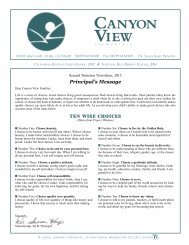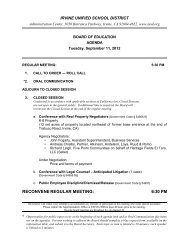reconvene regular meeting: 7:00 pm - Irvine Unified School District
reconvene regular meeting: 7:00 pm - Irvine Unified School District
reconvene regular meeting: 7:00 pm - Irvine Unified School District
Create successful ePaper yourself
Turn your PDF publications into a flip-book with our unique Google optimized e-Paper software.
Proposition 47<br />
The Class Size Reduction Kindergarten - University Public Education Facilities Bond Act of 2<strong>00</strong>2<br />
(“Proposition 47”) appeared on the November 5, 2<strong>00</strong>2 ballot as Proposition 47 and was approved by the<br />
California voters. This measure authorizes the sale and issuance of $13.05 billion in general obligation<br />
bonds for construction and renovation of K-12 school facilities ($11.4 billion) and higher education<br />
facilities ($1.65 billion). Some or all of the Participants have or are expected to receive funding from<br />
Proposition 47.<br />
Proposition 55<br />
On March 2, 2<strong>00</strong>4, the voters of the State approved Proposition 55, the Kindergarten-University<br />
Public Education Facilities Bond Act of 2<strong>00</strong>4. The act provides for a bond issue of $12.3 billion to fund<br />
education facilities and repair older schools in the State. Some or all of the Participants have or are<br />
expected to receive funding from Proposition 55.<br />
Article XIII C and Article XIII D<br />
On November 5, 1996, the voters of the State approved Proposition 218, also known as the “Right<br />
to Vote on Taxes Act.” Proposition 218 added Articles XIII C and XIII D to the State Constitution to<br />
require majority voter approval for the imposition, extension or increase of general taxes and two-thirds<br />
voter approval for the imposition, extension or increase of special taxes by a local government, which is<br />
defined in Proposition 218 to include counties. Among other things, Article XIII C establishes that every<br />
tax is either a “general tax” (imposed for general governmental purposes) or a “special tax” (imposed for<br />
specific purposes); prohibits special purpose government agencies such as school districts from levying<br />
general taxes except as allowed by Article XIII A; and prohibits any local agency from imposing,<br />
extending or increasing any special tax beyond its maximum authorized rate without a two-thirds vote.<br />
Article XIII D also provides that no tax may be assessed on property other than ad valorem property taxes<br />
imposed in accordance with Articles XIII and XIII A of the California Constitution and special taxes<br />
approved by a two-thirds vote under Article XIII A, Section 4.<br />
Article XIII C also expressly extends the initiative power to give voters the power to reduce or<br />
repeal local taxes, assessments, fees and charges, regardless of the date such taxes, assessments, fees or<br />
charges were imposed, and reduces the number of signatures required for the initiative process. Generally,<br />
the initiative process enables California voters to enact legislation upon obtaining requisite voter approval<br />
at a general election. Proposition 218 extends the authority stated in Rossi v. Brown by expanding the<br />
initiative power to include reducing or repealing local taxes, assessments, fees and charges, which had<br />
previously been considered administrative rather than legislative matters and therefore beyond the initiative<br />
power.<br />
Proposition 1A<br />
Proposition 1A (SCA 4) (“Proposition 1A”), proposed by the Legislature in connection with the<br />
2<strong>00</strong>4-05 Budget Act and approved by the voters in November 2<strong>00</strong>4, provides that the State may not reduce<br />
any local sales tax rate, limit existing local government authority to levy a sales tax rate or change the<br />
allocation of local sales tax revenues, subject to certain exceptions. Proposition 1A generally prohibits the<br />
State from shifting to schools or community colleges any share of property tax revenues allocated to local<br />
governments for any fiscal year, as set forth under the laws in effect as of November 3, 2<strong>00</strong>4. Any change<br />
in the allocation of property tax revenues among local governments within a county must be approved by<br />
two-thirds of both houses of the Legislature. Proposition 1A provides, however, that beginning in Fiscal<br />
F-4<br />
Page 202<br />
22314.4 033985 POS
















